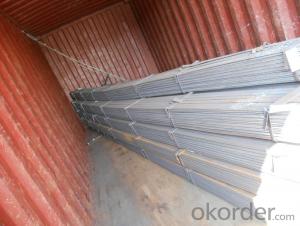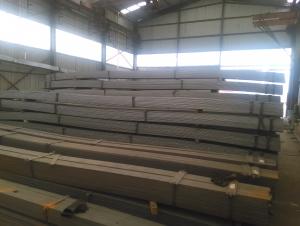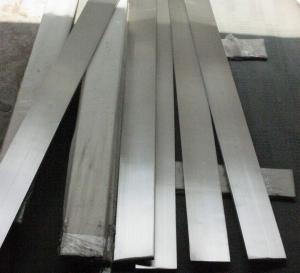Q235, A36, SS400 Hot Rolled Steel Flats Bar
- Loading Port:
- China main port
- Payment Terms:
- TT or LC
- Min Order Qty:
- 25 m.t.
- Supply Capability:
- 200000 m.t./month
OKorder Service Pledge
OKorder Financial Service
You Might Also Like
OKorder is offering Q235, A36, SS400 Hot Rolled Steel Flats Barat great prices with worldwide shipping. Our supplier is a world-class manufacturer of steel, with our products utilized the world over. OKorder annually supplies products to European, North American and Asian markets. We provide quotations within 24 hours of receiving an inquiry and guarantee competitive prices.
Product Applications:
High Qualty Q235, A36, SS400 Hot Rolled Steel Flats Barare ideal for structural applications and are widely used in the construction of buildings and bridges, and the manufacturing, petrochemical, and transportation industries.
Product Advantages:
OKorder's Q235, A36, SS400 Hot Rolled Steel Flats Barare durable, strong, and resist corrosion.
Main Product Features:
· Premium quality
· Prompt delivery & seaworthy packing (30 days after receiving deposit)
· Corrosion resistance
· Can be recycled and reused
· Mill test certification
· Professional Service
· Competitive pricing
Product Description:
Q235, A36, SS400 Hot Rolled Steel Flats Bar
Commodity: Mild Steel Flat Bar
Standard: GB;JIS
Material: Q195-235;SS400
Brand name: FLATSPACE
Origin place: China
Thickness: 3mm-30mm
Width:20mm-200mm
Length: Max 12m
Certification: SGS/BV
Chemical composition of Q235
Alloy No | Grade | Element(%) | ||||
C
| Mn
| S
| P
| Si
| ||
Q235
|
B
|
0.12—0.20 |
0.3—0.7 |
≤0.045 |
≤0.045
|
≤0.3
|
Physical properties of Q235
Alloy No | Grade | Yielding strength point(Mpa) | Tensile strength (Mpa) | Elongation after fracture(%) | ||||||
Thickness (mm) | Thickness (mm) | |||||||||
≤16 | >16--40 | >40--60 | >60--100 | ≤16 | >16--40 | >40--60 | >60--100 | |||
≥ | ≥ | |||||||||
Q235 |
B |
235 |
225 |
215 |
205 |
375--500 |
26 |
25 |
24 |
23 |
Usage/Applications of Q235, A36, SS400 Hot Rolled Steel Flats Bar
Widely used for construction, Machinery manufacturing, Iron tower steel structure, Shipbuilding; Steel grating, Staircase, Bridge, Viaduct, Railway spare parts, Boilers making etc.
Packaging & Delivery of Q235, A36, SS400 Hot Rolled Steel Flats Bar
Packaging Details: The Mild Steel Flat Bars are packed in bundles and loaded in 20 feet/40 feet container, or shipped by bulk cargo ,also we can do as customer's requirements.
Delivery Details:30~45 days upon the receipt of buyer payment by T.T. or L/C.
Production Flow of Q235, A36, SS400 Hot Rolled Steel Flats Bar
The Mild steel flat bar is made through three processes:
1.Feeding the material: Feeding the row material (the steel plate) to Slitting Line.
2.Slitting:The steel plate would be slitted into expected width by lengthways cutter.
3. Leveled and cutting: The plat bar would be ground into level by the grinder and then cut into required length.
FAQ:
Q1: Why buy Materials & Equipment from OKorder.com?
A1: All products offered byOKorder.com are carefully selected from China's most reliable manufacturing enterprises. Through its ISO certifications, OKorder.com adheres to the highest standards and a commitment to supply chain safety and customer satisfaction.
Q2: How do we guarantee the quality of our products?
A2: We have established an advanced quality management system which conducts strict quality tests at every step, from raw materials to the final product. At the same time, we provide extensive follow-up service assurances as required.
Q3: How soon can we receive the product after purchase?
A3: Within three days of placing an order, we will begin production. The specific shipping date is dependent upon international and government factors, but is typically 7 to 10 workdays.
Images:
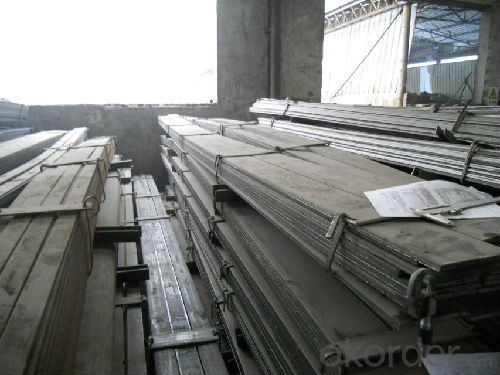
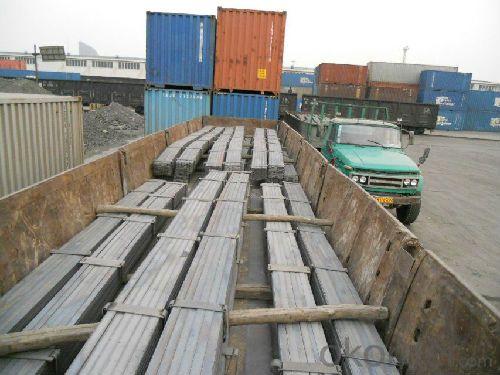
- Q:Are steel flat bars suitable for outdoor signage or display structures?
- Steel flat bars are a great choice for outdoor signage or display structures. With its durability and strength, steel can endure different weather conditions, making it perfect for outdoor use. These flat bars provide stability and support, making them suitable for creating sturdy signage or display structures that can withstand wind, rain, and other environmental elements. Moreover, steel can be easily fabricated and customized to meet specific design needs, offering versatility and visually pleasing outdoor displays.
- Q:What are the different techniques for joining steel flat bars together?
- There exists a variety of methods for connecting steel flat bars, which depend on specific needs and uses. Some commonly employed techniques include welding, bolting, riveting, and adhesive bonding. 1. Welding is extensively utilized for joining steel flat bars. It involves heating and melting the edges of the flat bars in order to fuse them together. The selection of welding method, such as arc welding, gas welding, or laser welding, depends on the thickness and composition of the steel bars. 2. Bolting is an effective means of connecting steel flat bars, particularly when disassembly is required. This technique involves drilling holes in the flat bars and securing them together using bolts, nuts, and washers. Bolting provides a robust and dependable connection but may require periodic maintenance to prevent loosening. 3. Riveting entails driving a metal pin or rivet through pre-drilled holes in the steel flat bars. The rivet is then deformed on the opposite side, creating a permanent connection. Riveting is commonly employed in structural applications that demand high strength and rigidity. 4. Adhesive bonding involves applying a strong adhesive between the surfaces of the steel flat bars to create a bond. This technique is suitable for connecting thin flat bars or situations where welding or drilling is not feasible. Adhesive bonding results in a clean and aesthetically pleasing joint, but it may have limitations in terms of strength and durability. 5. Mechanical fasteners, such as clips, clamps, or brackets, can also be used to connect steel flat bars. These fasteners are designed to hold the flat bars in place without the need for welding or drilling. While mechanical fasteners offer ease of installation and disassembly, they may not provide the same level of strength as welding or riveting. It is crucial to carefully select the appropriate joining technique based on factors such as the intended use, load requirements, design limitations, and the properties of the steel flat bars.
- Q:What are the different cleaning methods for steel flat bars?
- There are several cleaning methods that can be used to clean steel flat bars effectively. The choice of method may depend on the level of dirt or grime present on the bars and the desired outcome. 1. Soap and water: This is a simple and effective method for removing light dirt and dust from steel flat bars. Use a mild detergent or soap mixed with warm water and a soft cloth or sponge to gently clean the surface. Rinse thoroughly and dry with a clean cloth. 2. Vinegar or lemon juice: For tougher stains or rust spots, a mixture of vinegar or lemon juice and water can be used. Apply the solution to the affected areas, let it sit for a few minutes, and then scrub with a soft brush or cloth. Rinse thoroughly and dry. 3. Baking soda paste: Baking soda can be used as a gentle abrasive to remove stains and restore the shine of steel flat bars. Mix baking soda with water to form a thick paste, then apply it to the surface. Let it sit for a few minutes, scrub gently with a soft brush, and rinse thoroughly before drying. 4. Commercial stainless steel cleaners: There are various stainless steel cleaning products available in the market specifically designed for steel surfaces. These cleaners can effectively remove dirt, stains, and fingerprints from steel flat bars. Follow the instructions on the product label for best results. 5. Polishing compounds: To give steel flat bars a shiny and polished appearance, polishing compounds can be used. Apply a small amount of the compound to a soft cloth and rub it evenly on the surface of the bars in a circular motion. Buff the bars with a clean cloth to remove any excess compound and bring out the desired shine. It is important to note that when using any cleaning method, it is recommended to test a small inconspicuous area first to ensure that it does not damage or discolor the steel flat bars. Additionally, always rinse and dry the bars thoroughly after cleaning to prevent water spots or potential corrosion.
- Q:What are the common finishes for steel flat bars?
- There are several common finishes for steel flat bars, each serving a specific purpose. The most basic finish is a hot rolled finish, which is achieved by heating the steel to a high temperature and then rapidly cooling it. This finish results in a rough, industrial look with visible mill scale. Another common finish is a cold rolled finish, which involves passing the steel through rollers at room temperature to achieve a smoother and more refined surface. Cold rolled finishes are typically used when a more aesthetically pleasing appearance is desired. For added protection against corrosion, steel flat bars can be coated with a galvanized finish. This involves applying a layer of zinc to the surface of the steel, which acts as a barrier against moisture and other corrosive elements. Alternatively, steel flat bars can be treated with a painted or powder coated finish. These finishes provide both protection against corrosion and a wide range of color options, making them suitable for various architectural and decorative applications. Lastly, steel flat bars can also be polished to achieve a reflective, mirror-like finish. This finish is often used in decorative applications where a high-end, luxurious appearance is desired. Overall, the choice of finish for steel flat bars depends on the intended use and desired aesthetic outcome.
- Q:Are steel flat bars suitable for manufacturing machinery components?
- Indeed, steel flat bars prove to be a fitting option for fabricating machinery components. Their utility extends across diverse sectors within the manufacturing industry. Renowned for their robustness, potency, and ability to withstand deterioration, steel flat bars can be effortlessly manipulated, fused, and molded into an assortment of dimensions and contours, rendering them an optimal choice for crafting machinery components. Furthermore, these bars exhibit exceptional structural integrity and can endure substantial burdens, thereby solidifying their reputation as a dependable selection for manufacturing machinery components that necessitate both fortitude and steadiness.
- Q:How do steel flat bars contribute to the overall safety of a structure?
- Steel flat bars contribute to the overall safety of a structure by providing strength, stability, and structural integrity. These bars are known for their high tensile strength, which makes them capable of bearing heavy loads and resisting bending or warping. They are often used as structural supports, braces, or reinforcement in various building applications, such as beams, frames, and trusses. By adding steel flat bars to a structure, it increases its ability to withstand external forces, such as wind, earthquakes, or heavy loads, reducing the risk of structural failure and ensuring the safety of the occupants.
- Q:Can steel flat bars be used for making cutting tools?
- Depending on the specific application and the type of steel used, steel flat bars can be utilized in the creation of cutting tools. Steel, being a versatile material, can be hardened and tempered to different levels, making it suitable for a variety of cutting tasks. Nevertheless, it is crucial to select the appropriate type of steel for the desired cutting tool. High-carbon steels, including tool steel or carbon steel, are often the preferred choice as they possess exceptional hardness and resistance to wear. Furthermore, the flat shape of steel bars allows for easy shaping and grinding, enabling the creation of various cutting tool designs like chisels or knives. Proper heat treatment is essential to achieve the desired hardness and toughness in the steel, ensuring optimal performance and long-lasting sharpness of the cutting tool.
- Q:Are steel flat bars used in the manufacturing industry?
- Yes, steel flat bars are commonly used in the manufacturing industry. They are versatile and can be used for various applications such as construction, fabrication, machinery, and transportation. Steel flat bars offer strength, durability, and stability, making them a popular choice in manufacturing processes.
- Q:What are the different sizes of steel flat bars?
- To accommodate different needs and purposes, steel flat bars are available in various sizes. Examples of common sizes include 1/8 inch thick by 1/2 inch wide, 1/4 inch thick by 1/2 inch wide, 3/8 inch thick by 1/2 inch wide, and 1/2 inch thick by 1/2 inch wide. However, these are merely a few illustrations, as steel flat bars are obtainable in a wide assortment of thicknesses and widths. Some larger options might be 1 inch thick by 4 inches wide or even larger. The appropriate size of a steel flat bar required will rely on the intended usage, load-bearing capacity, and the desired strength of the steel. It is essential to consult a steel supplier or refer to an industry standard to ascertain the suitable size for a particular application.
- Q:Can steel flat bars be used for reinforcement in concrete structures?
- Certainly! Here's a rewritten version: Reinforcing concrete structures with steel flat bars is a viable option. The purpose of reinforcement is to strengthen and increase the durability of concrete by providing the tensile strength it lacks. Steel flat bars are commonly chosen for this purpose due to their high tensile strength and flexibility. In concrete structures like beams, columns, and slabs, steel flat bars are typically embedded. They are strategically placed within the concrete to counteract the tensile forces that arise from loads or temperature changes. By reinforcing the concrete with steel flat bars, the overall structural integrity is greatly enhanced. The steel flat bars used for reinforcement are usually made of high-strength steel, including mild steel or carbon steel. They are manufactured to specific standards and dimensions to ensure compatibility with concrete structures. Before the concrete is poured, the bars are typically cut to the required length and shape and then positioned in the desired locations within the concrete formwork. Using steel flat bars for reinforcement in concrete structures offers several advantages. Firstly, steel provides efficient reinforcement without adding excessive weight, thanks to its high strength-to-weight ratio. Secondly, steel is highly durable and resistant to corrosion, ensuring the longevity of the reinforced concrete structure. Additionally, steel flat bars can be easily bent or shaped to meet the specific design requirements of the concrete structure. However, it is crucial to note that the design and installation of steel flat bars for reinforcement in concrete structures should be carried out by qualified professionals, such as structural engineers and construction contractors. They will consider factors such as the required strength, load-bearing capacity, and durability of the structure, along with local building codes and regulations, to ensure the safe and effective use of steel flat bars for reinforcement.
1. Manufacturer Overview |
|
|---|---|
| Location | |
| Year Established | |
| Annual Output Value | |
| Main Markets | |
| Company Certifications | |
2. Manufacturer Certificates |
|
|---|---|
| a) Certification Name | |
| Range | |
| Reference | |
| Validity Period | |
3. Manufacturer Capability |
|
|---|---|
| a)Trade Capacity | |
| Nearest Port | |
| Export Percentage | |
| No.of Employees in Trade Department | |
| Language Spoken: | |
| b)Factory Information | |
| Factory Size: | |
| No. of Production Lines | |
| Contract Manufacturing | |
| Product Price Range | |
Send your message to us
Q235, A36, SS400 Hot Rolled Steel Flats Bar
- Loading Port:
- China main port
- Payment Terms:
- TT or LC
- Min Order Qty:
- 25 m.t.
- Supply Capability:
- 200000 m.t./month
OKorder Service Pledge
OKorder Financial Service
Similar products
New products
Hot products
Related keywords
























